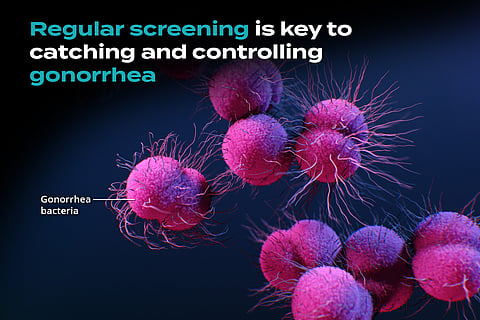Bridging the Gap - Health Equity for all
Hold Your Applause for the Clap and Get Screened Instead
<p>If you’ve been paying attention to news on sexually transmitted infection (STI) cases, you’ll know that infections like syphilis, chlamydia, and gonorrhea have gotten way worse in recent years. Public health officials are calling it an “STI epidemic”, and there’s talk of overhauling decades-old strategies to meet the crises of today.</p>
<p>Gonorrhea has seen a bit of a decline in the latest data (although this may simply be underreporting), but that does not mean we can rest easy about it. Case numbers are still way above what they were 10 years ago, so there’s no less reason to be vigilant about sexual health.</p>
<h2>What is gonorrhea?</h2>
<p>Nicknamed “the clap”, gonorrhea is an STI that is caused by the bacterium <em>Neisseria gonorrhoeae. </em>It’s the second most commonly reported STI in the US. Gonorrhea thrives in warm, moist areas of the reproductive tract, such as the cervix, uterus, fallopian tubes, and urethra. The infection can also be present in the throat, rectum, or eyes.</p>
<p>Gonorrhea affects people of all ages, but it is particularly prevalent among young adults aged 15 to 24.</p>
<figure><img alt="" height="360" src="https://cdn.storymd.com/optimized/Oo5pXZcDAK/original.jpg" width="639" />
<figcaption>Medical Illustration still showing Gonorrhea. <em>Source: Scientific Animations, Inc.</em></figcaption>
</figure>
<h3>Statistics on gonorrhea</h3>
<p>In 2014, there were over 350,000 cases reported to the CDC. In 2022, that number soared to 648,056, a slight decline over the previous year. There were over 2.5 million cases of syphilis, chlamydia, and gonorrhea reported in the US in 2022.</p>
<p>According to the WHO, there were around 87 million new cases of gonorrhea in 2016. Higher rates of the infection have been reported in low- and middle-income countries, but developed countries have sizable case numbers as well. In the US, there was a 56% hike in reported cases between 2015 and 2019. </p>
<h2>Spread and symptoms</h2>
<h3>Transmission</h3>
<p>Gonorrhea is mostly transmitted through sexual contact (vaginal, anal, or oral) with an infected individual. A pregnant woman with gonorrhea can also transmit the infection to her baby during childbirth.</p>
<h3>Symptoms</h3>
<p>Gonorrhea’s symptoms vary depending on where you are infected. Some people don’t experience any symptoms, making regular screening essential for those who are sexually active.</p>
<p>Common symptoms in men include:</p>
<ul>
<li>Painful/burning sensation when peeing</li>
<li>White, yellow, or green discharge </li>
<li>Painful or swollen testicles</li>
</ul>
<p>Common symptoms in women include:</p>
<ul>
<li>Painful/ burning sensation when peeing</li>
<li>Excess vaginal discharge</li>
<li>Vaginal bleeding between periods</li>
</ul>
<p>Other possible symptoms:</p>
<ul>
<li>Rectal pain, discharge, or bleeding</li>
<li>Sore throat</li>
<li>Eye infection (due to exposure to infected genital fluids)</li>
</ul>
<h3>Diagnosis</h3>
<p>Gonorrhea can be caught via a urine test, a swab test of the affected area (urethra, cervix, or throat, for example), or less commonly, a blood test.</p>
<h2>Treatment of gonorrhea</h2>
<p>Like its bedfellow chlamydia, gonorrhea is highly treatable with antibiotics. If you are prescribed antibiotics to beat gonorrhea, make sure to finish the full course; do not stop halfway even if symptoms clear up as it does not mean the infection is fully gone. </p>
<h2>Complications of gonorrhea</h2>
<p>We can cure gonorrhea, but if it’s left untreated, it can lead to severe complications:</p>
<ul>
<li><strong>Pelvic inflammatory disease (PID)</strong>. This affects roughly 10% to 15% of untreated women.</li>
<li><strong>Infertility in both sexes</strong>. PID can cause blocked fallopian tubes in women, while in men, untreated gonorrhea can lead to epididymitis, which affects sperm production and transport.</li>
<li><strong>Increased risk of ectopic pregnancy</strong>.</li>
<li><strong><strong>Increased risk of HIV transmission.</strong></strong></li>
<li><strong>Joint and skin infections.</strong></li>
</ul>
<ul>
<li><strong>Eye infections in newborns.</strong></li>
</ul>
<h2>Prevention</h2>
<p>Preventing gonorrhea with a condom is better than the hassle of a doctor’s visit and spending a week on antibiotics. Safe sex practices you can use to limit the risk include:</p>
<figure><img alt="" height="347" src="https://cdn.storymd.com/optimized/Roe7W8haqv/original.jpg" width="520" />
<figcaption>Colorful Condoms <em>Source: Bruno/Germany/Pixabay</em></figcaption>
</figure>
<ul>
<li>Limit your number of sexual partners</li>
<li>Talk about safe sex practices with your partner(s) to ensure they are getting checked regularly </li>
<li>Use condoms consistently and correctly </li>
<li>Get vaccinated against HPV and hepatitis B (this can reduce the risk of some STIs)</li>
<li>Attend regular STI screenings, especially if you have multiple partners</li>
</ul>
<h2>More on Gonorrhea</h2><ul><li><a href="https://soulivity.storymd.com/journal/qj358kbiam-gonorrhea" target="_blank">Gonorrhea (The Clap): Symptoms, Diagnosis, Treatment, Prevention</a></li><li><a href="https://soulivity.storymd.com/journal/jb8avxv02j-std-testing" target="_blank">Screening Tests for Sexually Transmitted Diseases (STDs)</a></li><li><a href="https://soulivity.storymd.com/journal/pwgrrxo14j-sexually-transmitted-diseases" target="_blank">Sexually Transmitted Diseases (STDs): Types, Symptoms, Treatment</a></li></ul>


